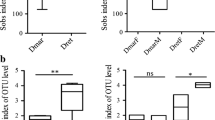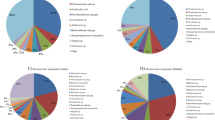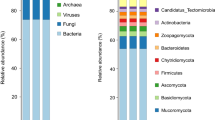Abstract
The Tibetan tick Haemaphysalis tibetensis is widely distributed in the Tibetan Plateau, and is recognized as one of the primary parasites affecting domestic and wild animals. No information is available on its microbial diversity. In the current study, the microbiomes in H. tibetensis were explored using Illumina MiSeq sequencing. Results indicate that a total of 28 phyla and 38 genera were characterized from this tick, and most of the microbes were classified in the phylum Proteobacteria. Female and male H. tibetensis harbored similar composition of the microbes, with dominant bacteria from the genus Coxiella accounting for 87.5 and 66.5% in females and males, respectively. The abundance of bacteria belonging to the genus Rickettsia in females and males was 6.9 and 23.7%, respectively. These findings may help understand the relationship between this tick and its symbiontic microorganisms.



Similar content being viewed by others
References
Ahantarig A, Trinachartvanit W, Baimai V, Grubhoffer L (2013) Hard ticks and their bacterial endosymbionts (or would be pathogens). Folia Microbiol 58:419–428
Andreotti R, de León AAP, Dowd SE, Guerrero FD, Bendele KG, Scoles GA (2011) Assessment of bacterial diversity in the cattle tick Rhipicephalus (Boophilus) microplus through tag-encoded pyrosequencing. BMC Microbiol 11:6
Budachetri K, Browning RE, Adamson SW, Dowd SE, Chao CC, Ching WM, Karim S (2014) An insight into the microbiome of the Amblyomma maculatum (Acari: Ixodidae). J Med Entomol 51:119–129
Carpi G, Cagnacci F, Wittekindt NE, Zhao F, Qi J, Tomsho LP, Drautz DI, Rizzoli A, Schuster SC (2011) Metagenomic profile of the bacterial communities associated with Ixodes ricinus ticks. PLoS ONE 6:e25604
Clay K, Fuqua C (2010) The tick microbiome: diversity, distribution and influence of the internal microbial community for a blood-feeding disease vector. In: Critical needs and gaps in understanding prevention, amelioration, and resolution of Lyme and other tick-borne diseases: the short-term and long-term outcomes. Workshop report. National Academies Press, Washington, DC
Clay K, Klyachko O, Grindle N, Civitello D, Oleske D, Fuqua C (2008) Microbial communities and interactions in the lone star tick, Amblyomma americanum. Mol Ecol 17:4371–4381
Dai J, Wang Y, Zhang L, Tang Y, Luo X, An H, Fang C (2009) Hymenobacter tibetensis sp. Nov., a UV-resistant bacterium isolated from Qinghai-Tibet plateau. Syst Appl Microbiol 32:543–548
Hoogstraal H (1965) Haemaphysalis tibetensis sp. n., and its significance in elucidating phylogenetic patterns in the genus (Ixodoidea, Ixodidae). J Parasitol 51:452–459
Huang XR, Chen J, Chen LY, Wu QL, Yang XX, Li XY, Li DR (2000) Studies on sedimentation coefficient and molecular weight of the orbivirus (Ti3010) isolated from Tibet, China. Bull Acad Mil Med Sci 23:269–271
Jasinskas A, Zhong J, Barbour AG (2007) Highly prevalent Coxiella sp. bacterium in the tick vector Amblyomma americanum. Appl Environ Microbiol 73:334–336
Jiang XT, Peng X, Deng GH, Sheng HF, Wang Y, Zhou HW, Tam NFY (2013) Illumina sequencing of 16S rRNA tag revealed spatial variations of bacterial communities in a mangrove wetland. Microb Ecol 66:96–104
Jin S, Wang TH, Liu M, Li T, Yang XL, Wang H, Jia QY, Yu ZJ, Liu JZ (2016) Scanning electron microscopy and morphometrics of all parasitic stages of the tick Haemaphysalis tibetensis Hoogstraal, 1965 (Acari: Ixodidae). Syst Appl Acarol 21:1202–1209
Liu LM, Liu JN, Liu Z, Yu ZJ, Xu SQ, Yang XH, Tuo Li, Li SS, Guo LD, Liu JZ (2013) Microbial communities and symbionts in the hard tick Haemaphysalis longicornis (Acari: Ixodidae) from north China. Parasit Vectors 6:310
Liu JN, Wang TH, Jia QY, Gao XH, Wan HL, Sun WY, Yang XL, Bao R, Yu ZJ (2016a) Characterization of the microbial communities in the ant lion Euroleon coreanus. Neotrop Entomol 45:397–403
Liu M, Li T, Yu ZJ, Gao XH, Zuo CW, Wang RR, Li NX, Wang H, Liu JZ (2016b) Characterization of the life cycle of the tick Haemaphysalis tibetensis under field conditions in Qinghai-Tibet plateau. Exp Appl Acarol 69:107–115
Liu M, Li T, Yu ZJ, Qiu ZX, Yan P, Li Y, Liu JZ (2017) Seasonal dynamics of the tick Haemaphysalis tibetensis (Acari: Ixodidae) in the Tibetan Plateau, China. Med Vet Entomol. doi:10.1111/mve.12248 (in press)
Menchaca AC, Visi DK, Strey OF, Teel PD, Kalinowski K, Allen MS, Williamson PC (2013) Preliminary assessment of microbiome changes following blood-feeding and survivorship in the Amblyomma americanum nymph-to-adult transition using semiconductor sequencing. PLoS ONE 8:e67129
Nakao R, Abe T, Nijhof AM, Yamamoto S, Jongejan F, Ikemura T, Sugimoto C (2013) A novel approach, based on BLSOMs (Batch Learning Self-Organizing Maps), to the microbiome analysis of ticks. ISME J 7:1003–1015
Narasimhan S, Fikrig E (2015) Tick microbiome: the force within. Trends Parasitol 31:315–323
Narasimhan S, Rajeevan N, Liu L, Zhao YO, Heisig J, Pan J, Eppler-Epstein R, DePonte K, Fish D, Fikrig E (2014) Gut microbiota of the tick vector Ixodes scapularis modulate colonization of the Lyme disease spirochete. Cell Host Microbe 15:58–71
Otranto D, Dantas-Torres F, Giannelli A, Latrofa MS, Cascio A, Cazzin S, Ravagnan S, Montarsi F, Zanzani SA, Manfredi MT, Capelli G (2014) Ticks infesting humans in Italy and associated pathogens. Parasit Vectors 7:328
Qiu Y, Nakao R, Ohnuma A, Kawamori F, Sugimoto C (2014) Microbial population analysis of the salivary glands of ticks: a possible strategy for the surveillance of bacterial pathogens. PLoS ONE 9:e103961
Smith TA, Driscoll T, Gillespie JJ, Raghavan R (2015) A Coxiella-like endosymbiont is a potential vitamin source for the Lone Star tick. Genome Biol Evol 7:831–838
Sonenshine DE, Roe R (2013) Biology of ticks, 2nd edn. Oxford University Press, Oxford
Teng GF, Jiang ZJ (1991) Economic insect fauna of China. Fasc. 39, Acarina, Ixodidae. Science Press, Beijing
Wang RR, Li NX, Liu JN, Li T, Liu M, Yu ZJ, Liu JZ (2017) Symbiont dynamics of the Tibetan tick Haemaphysalis tibetensis (Acari: Ixodidae). Parasit Vectors 10:259
Zhang PH, Cao JT, Li YC, Zhang QE (1996) Ultrastructure observation of newly GRD spirochetes isolate in Tibet. In: Zhang QE (ed) Corpus of epidemiological investigation, 2nd edn. Publishing House of Academy of Military Medical Sciences of PLA, Beijing
Acknowledgements
This work was supported by the National Natural Science Foundation of China (Nos. 31272372, 31400342, 31672365), Specialized Research Fund for the Doctoral Program of Higher Education of China (No. 20131303130001), the Natural Science Foundation of Hebei Province (C2015205124), and the Natural Science Research Programs of the Educational Department of Hebei Province (BJ2016032). We would like to thank Prof. Kenneth B. Storey and Rasha Al-attar from Carleton University, Canada for English editing.
Author information
Authors and Affiliations
Corresponding author
Ethics declarations
Conflict of interest
The authors declare no conflict of interest.
Electronic supplementary material
Below is the link to the electronic supplementary material.
Rights and permissions
About this article
Cite this article
Yu, Z., Wang, R., Li, N. et al. Microbial diversity of the Tibetan tick Haemaphysalis tibetensis (Acari: Ixodidae). Exp Appl Acarol 73, 237–244 (2017). https://doi.org/10.1007/s10493-017-0179-x
Received:
Accepted:
Published:
Issue Date:
DOI: https://doi.org/10.1007/s10493-017-0179-x




